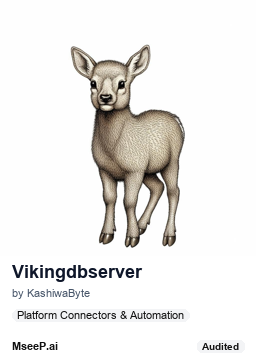About
The VikingDB MCP Server provides a lightweight interface for integrating the high-performance vector database VikingDB into Model Context Protocol workflows, enabling collection introspection, indexing, upsert and search operations via standard MCP tools.
Capabilities

The VikingDB MCP server bridges the gap between high‑performance vector search and conversational AI assistants. By exposing VikingDB’s powerful indexing, upsert, and search capabilities through the Model Context Protocol, Claude and other AI agents can seamlessly query vector embeddings stored in ByteDance’s cloud‑native database. This eliminates the need for developers to write custom API adapters, enabling rapid integration of semantic search into AI workflows.
At its core, the server offers a suite of intuitive tools that mirror VikingDB’s native operations. The collection‑intro and index‑intro tools provide metadata summaries, allowing an assistant to explain the structure of a collection or index before performing any actions. The upsert‑information tool lets the assistant ingest new embeddings or update existing records, while search‑information performs vector similarity queries and returns the most relevant results. These tools are designed to be invoked directly from a prompt, making it trivial for developers to embed complex search logic into conversational flows.
Key capabilities include secure authentication (access and secret keys), region‑aware connectivity, and configurable collection and index names. The server’s configuration is lightweight, requiring only a few parameters that can be supplied via environment variables or a simple JSON config file. Once running, the MCP server communicates over standard I/O, ensuring compatibility with any platform that supports the protocol. Developers can also harness the MCP Inspector for real‑time debugging, a critical feature when troubleshooting vector search latency or correctness.
Real‑world scenarios abound: an AI‑powered customer support bot can pull the most relevant product embeddings to answer queries; a research assistant can surface related papers from a large academic corpus stored in VikingDB; or a recommendation engine can dynamically upsert user preferences and retrieve personalized suggestions—all without writing bespoke API wrappers. The server’s tight integration with Claude’s prompt‑driven workflow means developers can focus on business logic rather than infrastructure plumbing.
In summary, the VikingDB MCP server delivers a plug‑and‑play vector search interface to AI assistants. Its straightforward toolset, secure configuration, and robust debugging support make it an attractive choice for developers looking to embed semantic search into conversational applications quickly and reliably.
Related Servers
MindsDB MCP Server
Unified AI-driven data query across all sources
Homebrew Legacy Server
Legacy Homebrew repository split into core formulae and package manager
Daytona
Secure, elastic sandbox infrastructure for AI code execution
SafeLine WAF Server
Secure your web apps with a self‑hosted reverse‑proxy firewall
mediar-ai/screenpipe
MCP Server: mediar-ai/screenpipe
Skyvern
MCP Server: Skyvern
Weekly Views
Server Health
Information
Explore More Servers
MCP USDA Server
LLM‑ready agricultural data from USDA FAS PSD
Karmada MCP Server
Unified multi-cluster configuration management for Karmada
Azure DevOps MCP Server
Bridge AI assistants to Azure DevOps with Model Context Protocol
Typesense MCP Server
AI‑powered search with Typesense integration
Terraform MCP Server
Seamless Terraform Registry integration for AI-powered IaC
OpenSearch MCP Server
Natural language interface to OpenSearch clusters